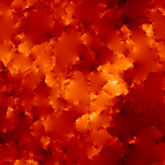


If cosmic defects have really formed in the early universe and some of
them are still within our present horizon today, the anisotropies in
the CMB they produce would have a characteristic signature. Strings,
for example, would imprint the background radiation in a very
particular way due to the Doppler shift that the background radiation
suffers when a string intersects the line of sight. The conical
topology of space around the string will produce a differential redshift of
photons passing on different sides of it, resulting in step-like
discontinuities in the effective CMB temperature, given by
 T / T
T / T
 8
8
 G µ
vs
G µ
vs
 with, as
before,
with, as
before,  = (1 - vs2)-1/2 the Lorentz
factor and vs the velocity of the moving
string. This `stringy' signature was first studied by
Kaiser & Stebbins
[1984]
and Gott [1985]
(see Figure 1.13).
= (1 - vs2)-1/2 the Lorentz
factor and vs the velocity of the moving
string. This `stringy' signature was first studied by
Kaiser & Stebbins
[1984]
and Gott [1985]
(see Figure 1.13).

|

|
Figure 1.13. The Kaiser-Stebbins effect for cosmic strings. A string network evolves into a self-similar scaling regime, perturbing matter and radiation during its evolution. The effect on the CMB after recombination leads to distinct steplike discontinuities on small angular scales that were first studied by Kaiser & Stebbins [1984]. The left panel shows a simulated patch of the sky that fits in one of the pixels of the COBE experiment. Hence, higher resolution observatories are needed in order to detect strings. The right panel shows a patch on the CMB sky of order 20' across. However, recent studies indicate that this clean tell-tale signal gets obscured at subdegree angular scales due to the temperature fluctuations generated before recombination. [Magueijo & Ferreira 1997]. |
Anisotropies of the CMB are directly related to the origin of
structure in the universe. Galaxies and clusters of galaxies
eventually formed by gravitational instability from primordial density
fluctuations, and these same fluctuations left their imprint on the
CMB. Recent balloon
[de Bernardis, et al.,
2000;
Hanany, et al., 2000]
and ground-based interferometer
[Halverson, et al., 2001]
experiments
have produced reliable estimates of the power spectrum of the CMB
temperature anisotropies. While they helped eliminate certain
candidate theories for the primary source of cosmic perturbations, the
power spectrum data is still compatible with the theoretical estimates
of a relatively large variety of models, such as
 CDM,
quintessence models or some hybrid models including cosmic defects.
CDM,
quintessence models or some hybrid models including cosmic defects.
There are two main classes of models of structure formation - passive and active models. In passive models, density inhomogeneities are set as initial conditions at some early time, and while they subsequently evolve as described by Einstein-Boltzmann equations, no additional perturbations are seeded. On the other hand, in active models the sources of density perturbations are time-dependent.
All specific realizations of passive models are based on the idea of
inflation. In simplest inflationary models it is assumed that there
exists a weakly coupled scalar field
 , called the inflaton,
which "drives" the (quasi) exponential expansion of the
universe. The quantum fluctuations of
, called the inflaton,
which "drives" the (quasi) exponential expansion of the
universe. The quantum fluctuations of
 are stretched by the
expansion to scales beyond the horizon, thus "freezing" their
amplitude. Inflation is followed by a period of thermalization,
during which standard forms of matter and energy are formed. Because
of the spatial variations of
are stretched by the
expansion to scales beyond the horizon, thus "freezing" their
amplitude. Inflation is followed by a period of thermalization,
during which standard forms of matter and energy are formed. Because
of the spatial variations of
 introduced by quantum
fluctuations, thermalization occurs at slightly different times in
different parts of the universe. Such fluctuations in the
thermalization time give rise to density fluctuations. Because of
their quantum nature and because of the fact that initial
perturbations are assumed to be in the vacuum state and hence well
described by a Gaussian distribution, perturbations produced during
inflation are expected to follow Gaussian statistics to a high degree
[Gangui, Lucchin, Matarrese
& Mollerach, 1994],
or either be products
of Gaussian random variables. This is a fairly general prediction that
will be tested shortly with MAP and more thoroughly in the future with
Planck. (16)
introduced by quantum
fluctuations, thermalization occurs at slightly different times in
different parts of the universe. Such fluctuations in the
thermalization time give rise to density fluctuations. Because of
their quantum nature and because of the fact that initial
perturbations are assumed to be in the vacuum state and hence well
described by a Gaussian distribution, perturbations produced during
inflation are expected to follow Gaussian statistics to a high degree
[Gangui, Lucchin, Matarrese
& Mollerach, 1994],
or either be products
of Gaussian random variables. This is a fairly general prediction that
will be tested shortly with MAP and more thoroughly in the future with
Planck. (16)
Active models of structure formation are motivated by cosmic topological defects with the most promising candidates being cosmic strings. As we saw in previous sections, it is widely believed that the universe underwent a series of phase transitions as it cooled down due to the expansion. If our ideas about grand unification are correct, then some cosmic defects should have formed during phase transitions in the early universe. Once formed, cosmic strings could survive long enough to seed density perturbations. Defect models possess the attractive feature that they have no parameter freedom, as all the necessary information is in principle contained in the underlying particle physics model. Generically, perturbations produced by active models are not expected to be Gaussian distributed [Gangui, Pogosian & Winitzki, 2001a].
16 Useful CMB resources can be found at http://www.mpa-garching.mpg.de/~banday/CMB.html Back.